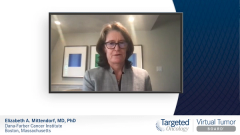
Case 1: Treatment Recommendations for PD-L1+ TNBC
The panel discusses treatment options and considerations for a 53-year-old woman with PD-L1+ triple-negative breast cancer.
Episodes in this series

Elizabeth A. Mittendorf, MD, PhD: I want to throw a little curveball into this conversation that will lead into our second case. I mentioned when I presented the patient that she had undergone genetic testing and was BRCA negative. Let’s say she’d been BRCA-positive, same neoadjuvant regimen, and same path, recurs now 18 months later. You actually have 2 approved agents. What do you think about the use of immunotherapy versus a PARP inhibitor in the patient with a BRCA mutation?
Ruta Rao, MD: Another excellent question. We don’t really have trials guiding us in that setting, whether we should use immunotherapy first or a PARP inhibitor first. I think we would, in a patient especially like this one we discussed, she has been through a lot of chemotherapy. If we could potentially avoid putting her right back on chemotherapy, we might think about putting her on a PARP inhibitor first and then using our chemotherapy, immunotherapy in the next line setting. It’s nice to know that we have 2, and we’re going to talk about this, but we have 2 PARP inhibitors approved for these patients who have germline BRCA mutations.
Elizabeth A. Mittendorf, MD, PhD: Good point. We’ll get to that with our next case. David, one thing we all hear about is TILs, tumor-infiltrating lymphocytes. We know that they predict response to chemotherapy from studies done in the neoadjuvant setting. If we think about immunotherapy as a treatment that’s designed to take the brakes off of the T cells, you could rationalize that if there are no T cells present, then what would you be taking the breaks off of? With that said, what do we know about the presence of TILs, and should we be looking for that in those metastatic specimens before instituting immunotherapy? With the presence of TILs, should that help guide that decision about immunotherapy versus PARP inhibitor? What do we know about the predictive value of TILs?
David G. Hicks, MD: We’ve known from even before the introduction of immune checkpoint inhibitors that TILs were predictive of a response to neoadjuvant chemotherapy in triple-negative and HER2-positive disease. I think the presence of TILs tells you that you have an immunologically activated or a so-called immune hot tumor. I get worried when they ask me to do PD-L1 testing on triple-negative breast cancer tissue and I look at the slide, and I don’t see any immune cells. It’s probably going to be negative. I think the presence of TILs certainly predicts for chemotherapy benefit. When they looked back at the IMpassion130 trial and they compared TILs and PD-L1, the benefit was in PD-L1–positive cancer regardless of the level of TILs. I think TILs are important, but the PD-L1 status is the thing that’s predictive. I just wanted to say, PD-L1 clearly is predictive of benefit from these agents, but it is not a perfect biomarker. I think an unmet need here is, are there better biomarkers that could give us a better sense of who’s going to benefit and who’s not? I think the research has looked at things like tumor mutational burden [TMB], which makes sense. That story is still evolving, but I think it’d be great if we had better predictive biomarkers than PD-L1.
Elizabeth A. Mittendorf, MD, PhD: You’re absolutely right. Back to Ruta’s comment, this is a situation where other histologies, other disease sites are a little bit ahead of us. The data about the tumor mutational burden that you’re referring to is much more advanced in melanoma, as an example. I will say that one of my colleagues at Dana-Farber Cancer Institute, Sara Tolaney, MD, MPH, is running a trial that’s looking at the use of a combination of nivolumab and ipilimumab in patients who have a high TMB. My understanding is the trial is accruing well, so hopefully, we’ll get some information about that. I think you’re entirely right. We need better biomarkers to identify who’s going to respond to these therapies.
On the bright side, I think it could be even more important that we get other therapies that work in triple-negative breast cancer, so we get the right therapy to the right person and perhaps not the toxicity. I think that’s another opportunity: biomarkers, not just of response, but of toxicity. Before we leave this case, Ruta, most of the data from IMpassion130 and KEYNOTE-355 suggest that there’s PFS [progression-free survival] benefit. Of course, it led to FDA approval of both agents, but there are patients who respond and then recur or progress. What is your strategy for the patient who progresses on either atezolizumab or pembrolizumab?
Ruta Rao, MD: I think at that point, we’re looking at some of our other standard chemotherapy drugs. We will be talking about this, especially in our third case, but we have an antibody-drug conjugate now that’s approved for patients with metastatic triple-negative breast cancer who have had 2 or more lines of prior therapy in the metastatic setting.
Elizabeth A. Mittendorf, MD, PhD: I hear people talk about maintaining folks on immunotherapy and just switching the chemotherapy. Do we have any data that would support that as a strategy to date?
Ruta Rao, MD: Not any phase 3 trials that we can follow. As a breast cancer medical oncologist, we’re very used to doing that in the HER2-positive setting, continuing Herceptin and changing out your chemotherapy. I think it’s something that we would like to do. We’ll have to wait and see what the data show.
Elizabeth A. Mittendorf, MD, PhD: There’s a lot of interest in that what we call “space” to investigate this. I want to pull this case together. As presented, it was a 53-year-old female who had been treated with neoadjuvant chemotherapy for triple-negative breast cancer with, arguably, not a great response. She still had nodal disease and a T2 tumor, and recurred about 18 months later and was found to have disease in the liver and lungs, PD-L1 positive. Based on the trial data from IMpassion130 and KEYNOTE-355, it’s appropriate to consider immunotherapy as the appropriate first line for her metastatic treatment. Again, some considerations as to which agent you use would be dictated by her prior chemotherapy and the time from that chemotherapy regimen.
Thank you all very much. That was a nice conversation. David, it was nice to have a pathologist at the table as we’re discussing doing the testing, as opposed to this email exchange that you referred to.
Transcript edited for clarity.












































